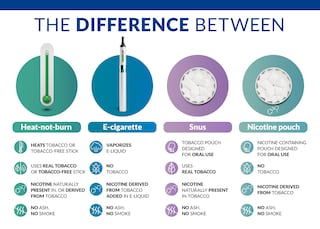PMI fully supports robust regulation of tobacco products
But the number of smokers is not predicted to significantly decline with current policies
Smokers who don’t quit deserve access to, and information about, better alternatives than continuing to smoke
Now more than ever, society is demanding action to combat the health and environmental threats we face.
The sense of urgency is palpable, with environmental campaigners hitting the headlines for their urgent calls to action.
Quitting on our planet would be unforgivable—for ourselves, our loved ones, and future generations.
As individuals, we generally accept policy changes that force a change in our behavior if it leads to a public benefit, such as the bans on lead in petrol and polluting vehicles in cities, CFCs in deodorants and fridges, and burning the stubble after harvesting cereal crops.

Why burning is the main problem
Why burning is the main problem
When tobacco is burnt, it can reach temperatures of around 900 degree Celsius.
It’s this extreme temperature that’s one of the problems with smoking
Burning breaks down the tobacco and produces smoke which contains more than 6,000 chemicals.
Around 100 of these chemicals have been identified by public health experts as causes or potential causes of smoking-related diseases.
Because there is no combustion in smoke-free products,
They have the potential to be better alternatives than continued smoking
*This is subject to scientific substantiation on a product-by-product basis.
The best choice any smoker can make is to quite cigarettes and nicotine use altogether.
Smoke-free alternatives are only for adult smokers who would otherwise continue smoking.
They are not risk-free and contain nicotine, which is addictive.
Music ends
But there are many areas where regulation can change behavior without outright bans, such as tax incentives for hybrid and electric-powered cars rather than combustion versions, energy efficient rather than incandescent lighting, metered water rather than fixed rates to encourage you to use less, and so on.
Fueled by this spirit, society expects the tobacco industry to make similar innovations to contribute to public health. To help move the millions of adult smokers away from cigarettes by giving them a choice of science-based alternatives that, although addictive and not risk-free, can be a better choice than continued smoking.
Innovation + regulation = benefit for public health
That’s what prompted us to transform our business to deliver scientifically-substantiated smoke-free alternatives to adult smokers who don’t quit tobacco or nicotine. Our products could deliver a significant global public health benefit if these smokers can access them, as well as accurate information about them.
We’re putting science at the forefront, and are asking regulators and politicians to make fact-based decisions based on robust scientific findings. Through this pragmatic approach, together we can pave pathways to change for adult smokers around the world, providing them with access to better alternatives and accurate information about them.
Blocking these pathways is counterproductive. Decision-makers are embracing emerging technologies and innovation to improve many areas of health and the environment. This is why we’re encouraging them to embrace products that science suggests have the potential to be less harmful than cigarettes—and urging them not to quit on those who don’t quit.
Opening up the debate
Perhaps the tobacco industry’s reputation—along with outdated misconceptions—are blurring critical faculties, and leading to skepticism. This mindset will not achieve the required change the world’s one billion smokers deserve.
We’re asking regulators to assess the publicly-available science and data relating to our smoke-free alternatives.
Nicotine is addictive and is not risk-free, but it is not the primary cause of smoking-related diseases. It is the high levels of harmful chemicals released when tobacco is burned. Smoke-free products do not burn tobacco, so their aerosols should contain fewer and lower levels of harmful chemicals compared to cigarette smoke. This needs to be scientifically assessed for each product.
We invite regulators to read the studies and scientific reviews of our science by independent researchers from universities and government research institutes. In general, the conclusions from these studies and reviews are in line with PMI’s own data.
Most importantly, the focus should be on the needs of adult smokers who would otherwise continue smoking. If these people don’t quit cigarettes and nicotine completely, they deserve the chance to switch to better alternatives that meet quality and safety standards.
Our products are for adult smokers who would otherwise continue to smoke. and we have in place a set of Good Conversion Practices that we apply wherever we commercialize our smoke-free products. They are not for youth, non-smokers or those who want to quit altogether.
We are transforming our company to deliver our smoke-free vision, and are openly sharing the results of our science to gain the trust of decision-makers, opinion leaders, scientific and medical communities, and society as a whole.
The world’s population is acting with urgency, purpose, and determination to create a better future for our society. Among them are the hundreds of millions of men and women who smoke. Without better alternatives, millions of them will continue smoking. So, it’s vital we don’t quit on them.




